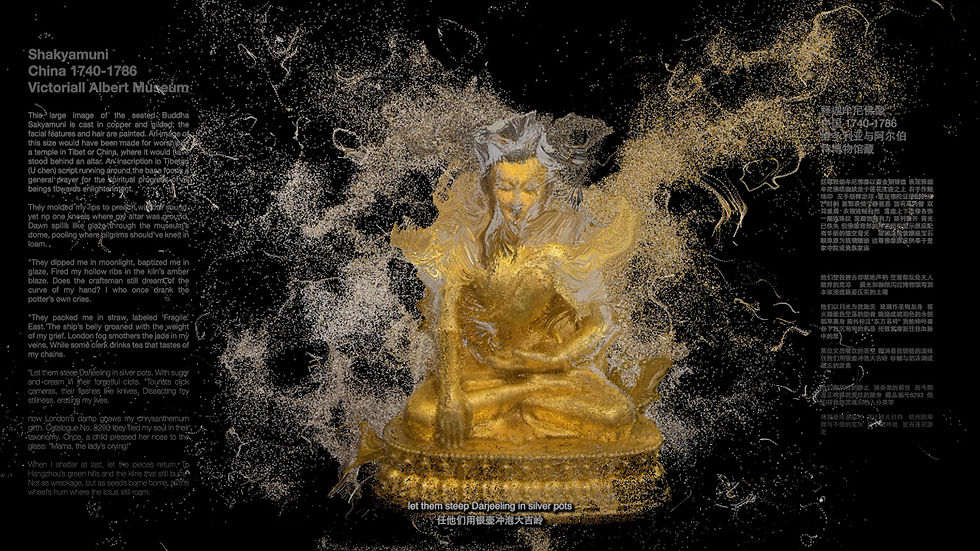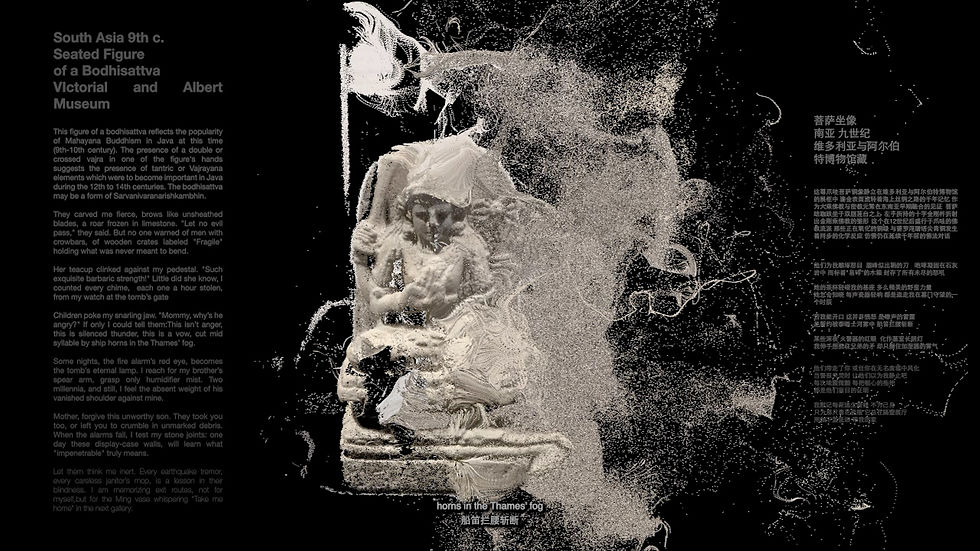Suwen Wang
- Anna Lilli Garai
- Aug 12
- 6 min read
Suwen Wang is a London-based artist and design researcher focusing on digital storytelling, cultural heritage, and immersive technologies. His work combines AI-generated voice, sound, and narrative to reimagine how displaced artifacts can express memory, longing, and identity. In projects like "ECHOES OF THE DISPLACED," he explores how emotional storytelling can reconnect audiences with cultural objects often viewed in silence. By treating AI as a collaborator rather than a tool, he builds layered, speculative narratives that highlight the emotional life of historical artifacts and invite viewers to listen more closely to the past.
Echoes of the Displaced - Experimental Filming, 2025
Q: What made you want to bring lost or displaced artifacts to life through storytelling?
A: As someone who grew up surrounded by ancient history—temples, relics, fragments of dynasties—I've always felt an emotional proximity to cultural artifacts. Yet as I matured, I became aware of the paradox: the closer I felt to these objects, the more I recognized a fundamental disconnection in how they are presented to the public. In museums, they are often stripped of emotion, treated as objects of beauty or historical record, but rarely allowed to "speak." Their silence haunted me.
Storytelling became my way of bridging this void. It allows us to reconstruct not just historical context, but emotional presence. Storytelling can transform a static relic into a living memory, and a displaced artifact into a witness of time, trauma, and longing. Through immersive storytelling, I aim to restore some of what was lost in displacement—not just origin, but identity.
By crafting sensory environments, voices, and digital worlds for these objects, I hope to activate a more intuitive form of understanding—one where people feel the artifact’s story, rather than just know it. In that emotional resonance, new relationships can emerge between viewers and the cultural past. Storytelling, in this way, becomes not only a method but a form of care.


Q: In "ECHOES OF THE DISPLACED" you treat AI almost like a character. How did that idea come to you?
A: This idea was born from a poetic symmetry I couldn’t ignore. In museums, cultural artifacts often sit quietly behind glass—viewed, admired, but rarely heard. They are treated as mute objects, devoid of agency. AI, similarly, is often regarded as nonhuman, synthetic, incapable of true thought or feeling. And yet, we constantly project meaning onto both: we imagine the stories behind the artifact, just as we imagine intelligence behind the algorithm.
I began to see AI not just as a tool, but as a conceptual mirror. What happens when two “voiceless” entities—AI and the artifact—are brought together in dialogue? Could one give voice to the other? Could they co-produce a kind of fictional soul? By treating AI as a co-performer or even a ghost narrator, I was able to create a voice that exists in between the human and nonhuman, past and future. The AI’s synthetic tone enhances the eerie distance of the artifact’s journey, yet paradoxically draws us closer by triggering empathy. This duality felt honest to the project. Both AI and heritage objects sit at the edge of humanity—strangely familiar, strangely foreign. And in that uncanny zone, something profoundly emotional can unfold.
Q: How do you decide what an artifact wants to express, or what it might sound like?
A: The process begins with a kind of listening—before any sound is made. I start by researching each artifact’s origin: where it came from, what it was used for, what beliefs it embodied, and how it ended up in its current location. But I don’t stop at historical facts. I also try to imagine the unrecorded moments: the hands that touched it, the environments it once belonged to, the ruptures it endured. Then I ask: if this object had a voice, what would it remember? What would it mourn? What would it wish to say that history books cannot? From there, I imagine its emotional profile—its tone, rhythm, tempo, and vulnerability. I assign it a persona, not in a theatrical sense, but in a soulful one.
The AI tools I use allow me to experiment with these ideas in audio form. I play with vocal timbres, pitch, digital texture, and silence. The voice might be cracked, delayed, echoing, or sharp—depending on the object’s emotional weight. The goal isn’t realism. It resonates.
I want the voice to feel like it has felt. In the end, the sound of each artifact is a composite of research, imagination, and digital experimentation—a speculative biography expressed in voice and tone.

Q: You talk about the “heritage empathy gap.” What moments have shown you that your work is helping to close it?
A: The "heritage empathy gap" refers to a cultural numbness I’ve observed—where artifacts are admired but not truly felt, where heritage is seen as aesthetic, but not emotional. This gap is especially evident when cultural objects are removed from their origins and placed in sterile environments, often without the stories that gave them meaning. I first began to understand this gap through my own experience—growing up in an ancient Chinese town, walking past ruins not as a tourist, but as a child of that soil. Over the years, I saw how cultural objects were trafficked, stolen, or displayed without care. That left a mark on me. When I began sharing "ECHOES OF THE DISPLACED", I noticed how differently people responded when they heard the artifact’s voice. I’ve seen viewers fall silent, lean closer, sometimes even tear up. They were no longer observing—they were listening, imagining, empathizing. One moment I’ll never forget was when a viewer said: “I never thought of an artifact as lonely before.” That sentence alone was proof that emotional storytelling can pierce through the layers of institutional detachment. It can activate a new mode of seeing—one rooted in intimacy, grief, and responsibility. That’s when I knew the work was doing what it was meant to do.
Q: Your work deals with emotional topics but uses cutting-edge tools. How do you keep it feeling human?
A: I approach technology not as an aesthetic in itself, but as a language—a way of amplifying inner voices, both human and nonhuman. While I use cutting-edge tools like AI-generated scripts, 3D scans, generative voice models, and immersive sound design, these tools are always in service of something deeply human: emotion, memory, and connection.
The humanity in my work doesn’t come from analog textures or warm colors—it comes from intention. Every narrative I generate begins with a question: what is this object trying to tell us, and how can I make others care? The AI voice is carefully chosen to reflect specific emotional registers—sometimes fragile, sometimes glitchy, sometimes unbearably calm. The visual world is designed to evoke a feeling of exile or longing. I also embed imperfections—pauses, distortions, moments of silence—because that’s where the human slips through. Emotion doesn’t lie in resolution; it lies in vulnerability. By blending precise technology with narrative intuition, I try to build a world that doesn’t just inform, but moves. That’s how I keep it feeling human.
Q: What do you hope people feel or think about after seeing "ECHOES OF THE DISPLACED"?
A: I hope people leave with a softened gaze and a sharpened mind. I want them to feel a lingering discomfort—not in a negative sense, but in the way that meaningful art often unsettles us. I hope they begin to see cultural artifacts not as dead things behind glass, but as displaced presences, each carrying an echo of a world we might never fully understand.
I also hope it provokes self-reflection. How do we interact with cultural memory? What is our role in preserving, respecting, and listening to the past? Are we observers or participants? Are we protectors or consumers?
In a time when digital media is often fast, shallow, and visual-first, I want this work to offer a slower, deeper encounter—where sound, silence, and emotion carry equal weight. Most of all, I hope people begin to ask more questions. I hope they return to museums not only to look, but to listen. I hope they start seeing ruins not as empty spaces, but as full of time. I hope they recognize that empathy for the past is not nostalgic—it’s essential. It is what reminds us who we are, and what we stand to lose.








